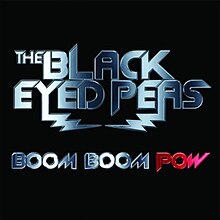 | Boom Boom PowBlack Eyed Peas |
Writer(s): William Adams, Allan Pineda, Jaime Gomez, Stacy Ferguson (see lyrics here) Released: November 12, 2008 First Charted: March 8, 2009 Peak: 112 US, 15 BA, 110 DG, 16 RR, 21 A40, 51 RB, 12 UK, 19 CN, 16 AU, 21 DF (Click for codes to charts.) Sales (in millions): 6.9 US, 0.73 UK, 27.0 (includes US + UK) Airplay/Streaming (in millions): 0.5 radio, 367.9 video, -- streaming |
Awards:Click on award for more details. |
About the Song:With their lead single from their fifth studio album, The E.N.D., the Black Eyed Peas achieved a feat they hadn’t accomplished before – they topped the Billboard Hot 100 in the U.S. The song spent an amazing 12 weeks atop the charts – but it was only the beginning. The Peas didn’t have to wait long for their next #1 – the album’s follow-up single, “I Gotta Feeling,” followed “Pow” into the pole position, giving the Peas the rare distinction of knocking themselves from the top. “Feeling” proved even more successful, holding on to #1 for 14 weeks – giving the Peas a full six-month lock on #1! All four members – Will.i.am, Fergie, Taboo, and apl.de.ap – have solo raps in the futuristic-sounding, auto-tuned song. Boston Globe described the song and others from the album as “substance-free, grammatically suspect dance floor jams” which were nonetheless “booty-shaking pleasures.” WK Digital Spy’s Nick Levine called it “a fairly ridiculous robopop stomper” but also said, “Frankly who cares? Right now this just sounds cracking.” WK Rolling Stone said it was “an assault on the senses, and on good taste. And it’s the best thing The Black Eyed Peas have ever recorded.” WK Will.i.am acknowledge the song’s unusual and repetitive nature when he told Rolling Stone, “It has one note. It says ‘Boom’ 168 times. The structure has three beats in one song. It’s not lyrics – it’s audio patterns, structure, architecture.” SF He told Billboard the song “was made for underground clubs. Like, if I would’ve thought that was gonna be a radio song, I would’ve made it different…‘Boom Boom Pow’ is proof that if something’s dope, regardless of if it has that sprinkled radio vibe, that it should be played on the radio and the people are gonna like it.” WK People definitely liked it. They watched the video on YouTube more than 100 million times WK and scooped up 6 million copies of the song in the U.S. and another 2.5 million internationally. It was the best-selling song on iTunes in 2009. It was a big seller right out of the gate, hitting 465,000 downloads in its first week, making it the highest sum which had been achieved at that point by a group in one week. SF Resources:
Related Links:Last updated 4/25/2023. |











